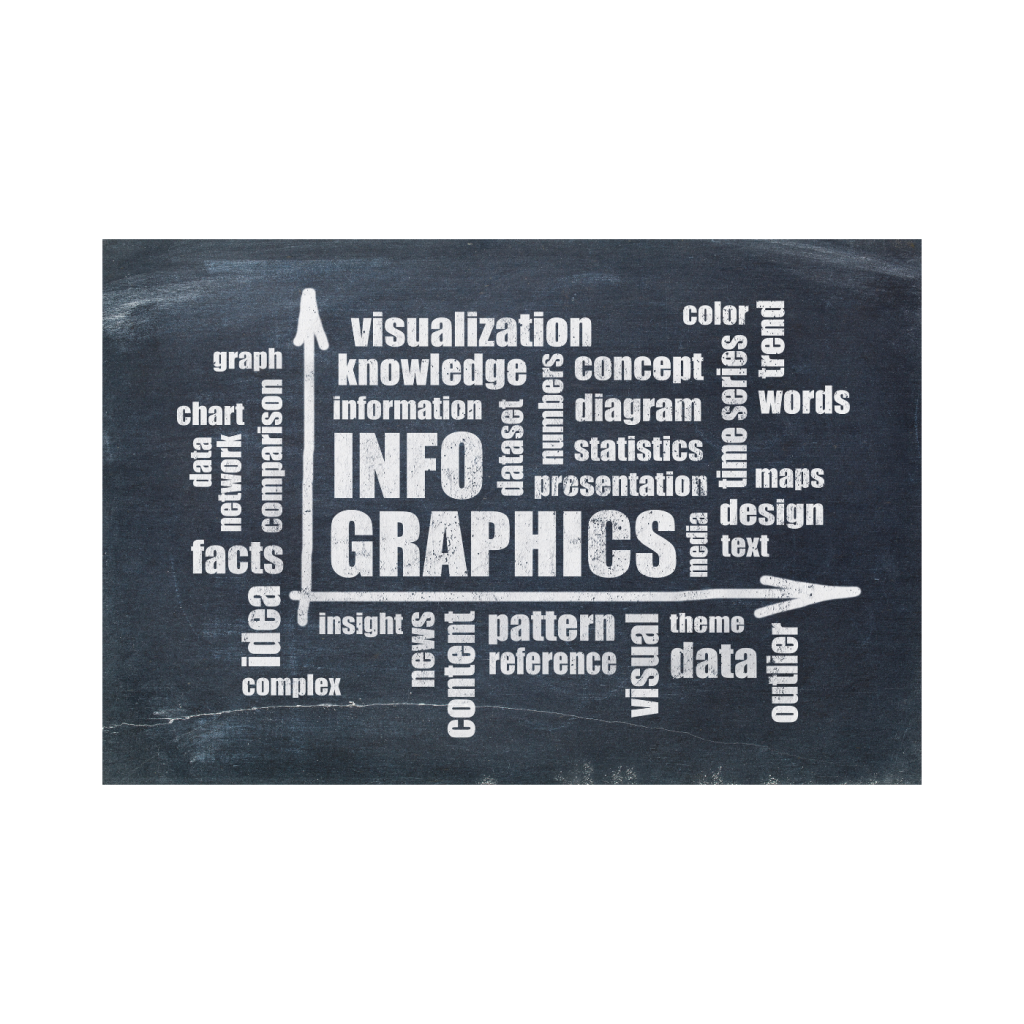The Power of Visual Storytelling
for Your Brand
Introduction to
Infographics
In an age where consumers are bombarded with massive amounts of information daily, breaking through the noise and capturing attention can be a challenge. This is where infographics come in. Infographics are a powerful tool for simplifying complex information, making data more accessible, and presenting ideas in a visually appealing and memorable way.
Infographic design combines data, content, and visual elements to tell a compelling story. By presenting information in a structured and visually engaging format, infographics make it easier for audiences to digest and retain critical details. They can be used in various contexts, from marketing and education to corporate presentations and social media.
As part of your visual content marketing strategy, infographics can drive more traffic to your site, increase engagement, and improve brand awareness. Furthermore, well-designed infographics can also have significant SEO benefits, helping you rank better in search engines and acquire valuable backlinks.
This guide will explore the essential aspects of creating impactful infographics, from design principles and data visualization techniques to SEO for infographics and distribution strategies.

Design Principles for
Effective Infographics
To create an infographic that resonates with your audience and delivers your message effectively, you must follow key infographic design best practices. These principles ensure that your visual content is not only attractive but also easy to understand and aligned with your communication goals.
Choosing the Right Infographic Format
Different types of infographics serve different purposes. Some common formats include:
By selecting the right format, you can make sure your infographic communicates the information most effectively. For instance, timeline infographics can work well for company milestones or product development, while statistical infographics are perfect for showcasing survey results or market data.
Perfect for showcasing historical data or a sequence of events.
Used for presenting data-heavy information in a digestible way.
Helpful for showing differences between two or more products, services, or ideas.
Ideal for explaining steps in a process or how something works.
Infographic Design
Best Practices
The success of your infographic depends largely on its design. Here are some key design principles to keep in mind:
Avoid clutter and focus on the core message you want to communicate. Keep text minimal and ensure visuals do the heavy lifting.
Organize the information in a way that guides the viewer’s eye, typically from top to bottom or left to right. Use headings, subheadings, and bullet points to create a clear hierarchy.
Color plays a huge role in making your infographic visually appealing. Stick to a cohesive infographic color scheme that aligns with your brand, but ensure it doesn’t overwhelm the viewer. Contrasting colors can be used to highlight important data points.
Use clear and legible fonts. Vary font size to emphasize key points, but don’t use too many font types. Two or three fonts are typically enough.
Don’t be afraid of white space. It helps prevent overcrowding and allows the reader to focus on key elements.
Custom vs Template Infographics
When designing infographics, businesses often face the decision of choosing between custom vs template infographics. Custom-designed infographics are tailored specifically to your brand and message, making them unique and memorable. On the other hand, template infographics can be faster and more cost-effective, though they may lack originality.
If you’re looking for something unique that represents your brand, opting for a custom infographic is ideal. However, templates are a good option for businesses just starting out or for internal presentations.


Data Visualization Techniques
Infographics are centered around data visualization, which means converting raw data into visual elements like graphs, charts, and diagrams that make information easy to understand at a glance.
Converting Data into Infographics
Converting data into infographics requires selecting the right type of visual representation for your data. Here are some common methods of data visualization:
- Bar charts and line graphs are ideal for showing trends or comparing quantities.
- Pie charts are useful for representing proportions or percentages.
- Maps can be used to show geographic data or demographic information.
- Flowcharts can help illustrate processes or decision-making steps.
The key is to choose a visual format that communicates your data clearly and effectively. It’s essential that your infographic accurately reflects the data and doesn’t mislead the viewer by overcomplicating or distorting the information.
Storytelling with Infographics
One of the greatest strengths of infographics is their ability to tell a story visually. Storytelling with infographics involves organizing your data and design elements in a way that takes the viewer on a journey, from problem to solution or from question to answer.
To do this, structure your infographic like a narrative:
- Introduction: Present the key message or problem your infographic addresses.
- Body: Use data visualization to support your points, providing explanations and context.
- Conclusion: Offer a solution, call to action, or summary of the main takeaway.
Storytelling helps make your infographic more engaging and memorable, encouraging users to share it with others.


Interactive Infographics
Incorporating interactivity into your design can take your infographic to the next level. Interactive infographics allow users to engage with your content, explore different sections, and reveal more information with clicks or hover effects. These types of infographics can be particularly effective in digital marketing campaigns, as they boost engagement and keep users on your page longer.
SEO Strategies for
Infographics
Infographics are not only valuable for engaging audiences—they can also help improve your search engine rankings. When optimized correctly, infographics can generate backlinks, drive organic traffic, and improve your overall site authority. Here’s how you can use SEO for infographics to boost your website’s visibility.
SEO for Infographics
Infographics can be an effective way to build backlinks, as websites and blogs often link back to original sources of compelling visuals. To optimize your infographic for SEO:
Just like with blog posts, it’s important to include relevant keywords in your infographic titles, descriptions, and alt text. This will help search engines understand the content of your infographic and rank it accordingly.
Ensure that your infographic’s file name contains relevant keywords, and include descriptive alt text to boost its visibility in image search results.
Provide an easy-to-use embed code for your infographic, which encourages other websites to share it and link back to your site.
The text surrounding your infographic should also be SEO-friendly, providing context and supporting your visual content.
Infographics for Link Building
Infographics are particularly useful for link building. If your infographic presents unique data, statistics, or a fresh perspective on a topic, other websites are likely to link back to it. The more valuable and shareable your infographic, the more backlinks it can generate.
Promote your infographic through outreach to influencers, bloggers, and industry publications. Submit it to infographic submission sites, which are designed to share and distribute visual content, further increasing your chances of earning backlinks.

Distribution Channels for
Maximum Reach
Creating an amazing infographic is only half the battle. Infographic distribution is just as crucial to ensure that your content reaches your target audience. There are several effective channels for distributing infographics, and each offers unique opportunities to expand your reach.
Infographic Distribution
Channels
Infographics perform particularly well on social platforms like Pinterest, Instagram, and LinkedIn, where visual content is prioritized. When distributing infographics on social media, be sure to optimize for each platform’s image dimensions and include relevant hashtags.
Embed your infographic in relevant blog posts or landing pages. Pair your infographic with well-written content that explains or expands on the visual information.
Infographics are a great way to break up text in newsletters and drive more engagement. Use infographics for newsletters to highlight key statistics, showcase products, or share updates in a visually appealing format.
Submit your infographic to specialized sites like Visual.ly, Infographic Journal, or Reddit’s infographics section to increase exposure and attract backlinks.
Partner with influencers or thought leaders in your industry to share your infographic with their followers. Influencer videos or posts that feature your infographic can give it the viral boost needed to reach a wider audience.
Promoting Infographics Effectively
To ensure maximum visibility, combine organic and paid promotion tactics. Use promoting infographics effectively by leveraging paid social media ads, Google Ads, and sponsored content. Amplify your reach by targeting specific demographics and interests aligned with your infographic’s message.
Mobile-Friendly Infographics
With mobile traffic now surpassing desktop traffic, it’s critical that your infographic is optimized for mobile viewing. Mobile-friendly infographics should be easily readable on smaller screens, with larger fonts, simplified layouts, and responsive designs. Ensure that the file size is optimized for fast loading, as slow-loading visuals can deter users from engaging with your content.


Conclusion: Enhancing Information Retention
Infographics are an incredibly effective tool for simplifying complex information, engaging audiences, and boosting brand visibility. By following the best practices for infographic design, using compelling data visualization techniques, and implementing strong SEO strategies, you can create infographics that not only captivate your audience but also enhance your overall content marketing efforts.
Whether you’re looking to boost engagement on social media, improve your website’s SEO, or communicate data in an engaging way, infographics are a versatile and powerful medium. With a solid distribution plan, you can maximize the reach and impact of your infographics across multiple channels, driving more traffic and conversions.
At Nerve Agency, we specialize in creating custom infographics that tell your story visually. From infographic designand data visualization to SEO optimization and distribution, we help you craft impactful visual content that resonates with your audience. Contact us today to learn how we can design infographics that elevate your brand and boost your digital marketing efforts. Let’s bring your data to life with captivating visuals that make an impact!
